


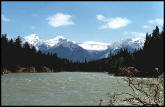
It was in 1995 that our Canadian friend of long standing Ralph, who was Canadian born but of Scottish descent, and lived in Chilliwack, British Columbia encouraged my wife Edith and I to take our annual holiday in Western Canada. So it was in early May of that year that we boarded a Charter Flight at Glasgow Airport and headed for Western Canada,via Iceland for a refueling stop, to be met at Vancouver Airport by Ralph who transported us to his home in Chilliwack which was situated about 100 miles East of Vancouver on the Fraser River. So commenced a wonderful three week holiday of absolute delight and amazement.
The first few days were spent in and around Chilliwack where the highlights were a visit to Minter Gardens, Harrison Springs on Harrison Lake and Hope. Minter Gardens in particular had long
been on our hit list for a visit since we had received annually at Christmas, the following years Calendar of the wonderful views from the gardens and the exquisite display of plants, shrubs and trees. On the day of our visit, the backdrop was of bright blue sky framing the huge snow white peaks of the mountains. In the foreground were the various shapes of the Western Red Cedars (Thuya Plicata) and the splash of colours of the plants and bushes surrounded by the manicured lush grass. It truly lived up to our expectations.
But time was running short already. We had pre booked a sea journey through the Inside Passage from Port Hardy on the North tip of Vancouver Island to Prince Rupert on the Alaskan border. So a car was hired in Chilliwack and my wife and I set off on our two week 2400 mile journey which would take us to Vancouver Island, Prince Rupert, the Skeena River valley and the Yellowhead Highway to Jasper then down the Icefield Parkway via Jasper National Park, the Columbian Icefield, Lake Louise and Banff Springs.
We set off on the spectacular journey to Vancouver Island by ferry through the Gulf Islands and saw a shoal of killer whales on the way! On arrival on Vancouver Island and within a few miles we reached the second of the magnificent gardens in this part of the World - Butchart Gardens. Formed from an old Limestone Quarry by Mrs Butchart, this 50-acre gardeners' paradise delighted us even more than Minter Gardens. The mild climate on Vancouver Island allowed even more exotic plants and shrubs to be grown in this old quarry . We had to drag ourselves away and head down to Victoria where we planned a two night stay. A guided tour of the town of Victoria ensued the following day and yet again we marveled at the magnificent grand old Empress Hotel (where we treated ourselves to afternoon tea), the large array of Totem Poles, the palatial dwellings of the Oaklands Area of the town together with elegant government buildings. Victoria, of course, is the capital of British Columbia.
It was early the next day that we set off for Port Hardy hugging the coast line of the Strait of Georgia and then on via the salmon-rich Campbell River eventually arriving in Port Hardy during the early evening. We were up early the next morning to catch the Prince Rupert ferry which left at 0630 hours. Relieved that our booking had been successful we were welcomed aboard what appeared to us to be a small cruise ship for the 16 hour sail up the Inside Passage. The food served to us on board together with spectacular views of snow capped mountains clad in Western Red Cedar on both sides of the ship and the fast flowing rivers and waterfalls made the trip pass very quickly as we arrived in Prince Rupert during the late evening. For this part of our trip we stayed in Motels which without exception we found to be first class accommodation. They were reasonably priced and all invariably had superb restaurants. Our Motel in Prince Rupert was no exception. Prince Rupert appeared to us to be a very isolated small fishing port situated on the Skeena River. It was however, busy with many small boats some used for fishing and others used by Foresters to transport them with their stocks of Western Red Cedar transplants and other equipment to even more isolated locations round the coastline. Many Bald Headed Eagles were seen as they scavenged for fish around the harbour area or swooped down on the unsuspecting salmon in the Skeena River. The Skeena River was originally one of the best salmon rivers in the world and supported many salmon canning factories but those have just about completely disappeared.
We set off along the Yellowhead Highway later in the morning. This Highway runs all the way to Jasper and for the first part follows the Skeena River and the railway line. This scenario allowed us to appreciate just how the communication system of Western Canada evolved. First there was river travel, some by flat bottomed stern wheelers, then followed the railways and thereafter the surfaced roads. We were heading for Smithers where we stayed at the Hudson Bay Lodge for the night.
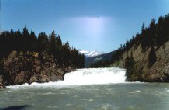
The Bow River (above) and the Falls (below) at Banff Springs
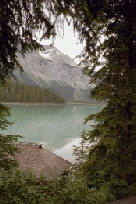
Then we made for Jasper via Prince George and had our eyes peeled all along this route to see if we could see any bears, especially the Black Bear. Many Elk were seen but alas no Black Bears!! Mount Robson was passed on the way but it was getting late and we unfortunately didn't have time to visit the Mount Robson Visitor Centre to view the highest mountain of this part of the Rockies. So Alberta was reached and we soon were tucked up in bed at our Jasper Motel after a very long day indeed.
The first day full day in Jasper was spent in Jasper National Park where we first of all visited Maligne Canyon, Maligne Lake, Medicine Lake part of the Athabasca River and Mount Edith Cavell. We saw many chip monks, ground
and tree squirrels, bighorn sheep, elk, deer and it was whilst we were returning from Maligne Lake that we got our biggest thrill of all. We stopped by the roadside right beside a Black Bear. It was munching dandelions literally three feet from the car window. We sat and watched him for about ten minutes and he didn't even bother to look up! Edith even managed to quietly open the car window and she got marvelous video footage with the munching sound on the video as well.
We were surrounded by the Queen Elizabeth Range of mountains and since it was a wet and windy day with much low cloud, the whole area appeared very isolated. In addition there were not many visitors about to add to the isolation of the area. It was below this range of mountains that Medicine Lake was spread out before us. This has always been an eerie place since the Lake in early June was only half full. Apparently, the Lake drains out in the Autumn into underground reservoirs and it is not until the snow melts in the Spring that the Lake starts to full up for the Summer. The Native Canadians couldn't understand this and thought it was to do with their Medicine Man and thus called it Medicine Lake.
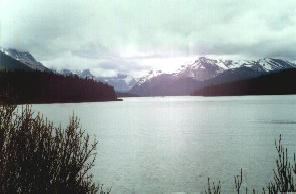
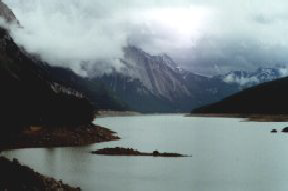
Maligne Lake (above left) and Medicine Lake (above right)
Our first port of call the next morning was the Athabasca Falls on the Athabasca River. Again the day was overcast with low cloud and it had been raining all night. However when we arrived at the falls, it was dry but the river was full to capacity and flowing very fast. Accordingly we had a marvelous experience of the roar of the water as it poured over the falls. Bow Lake was the next stop and must have been at a higher elevation than the other lakes we had visited since it was still frozen up over a quarter of its area. It is from this Lake that the Bow River commences its journey to-wards Banff Springs. The weather improved somewhat thereafter which allowed us to take the huge wheeled vehicles (the famous Snow coaches) which transport tourists up onto the Athabasca Glacier. This is part of the Crowfoot Glacier of the Culumbian Icefield. The Snowcoaches drop you off onto the Glacier at a height of about 10000 feet above sea level where the ice is 1000 feet thick below your feet. The cloud had now lifted to produce bright blue sky. The peaks of the surrounding mountains were still snow capped and I can assure you that is was indeed cold. It was a welcome return to the heated Snow coach for the return down to the Icefield Parkway where we continued our journey to Lake Louise and a two night stay in a lovely old wooden Motel/Inn on the shores of Lake Louise. Moraine Lake and Emerald Lake were visited during the next two days as well as Kicking Horse Pass and the Spiral Tunnels situated half down the Pass. The tunnels are a system of making the gradient for the trains such that they can descend safely. The two tunnels go into the mountains in large semi-circles. From the viewpoint on Kicking Horse Pass we actually saw a couple of trains pass from well above us at the rear to well below us to the front. Whilst the train was exiting from the Tunnel, the rear of the train was still entering at a higher level. What a feat of engineering !




